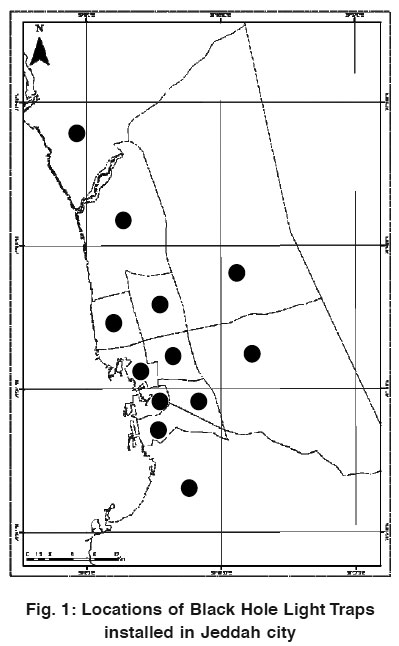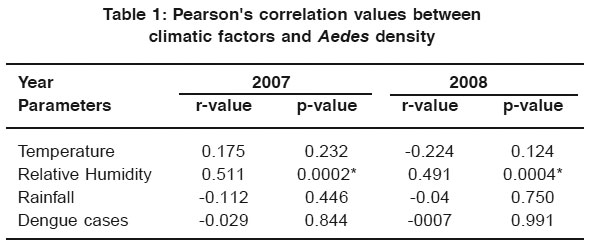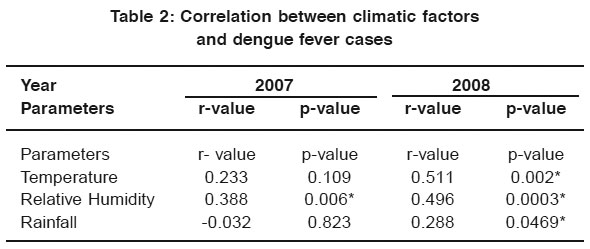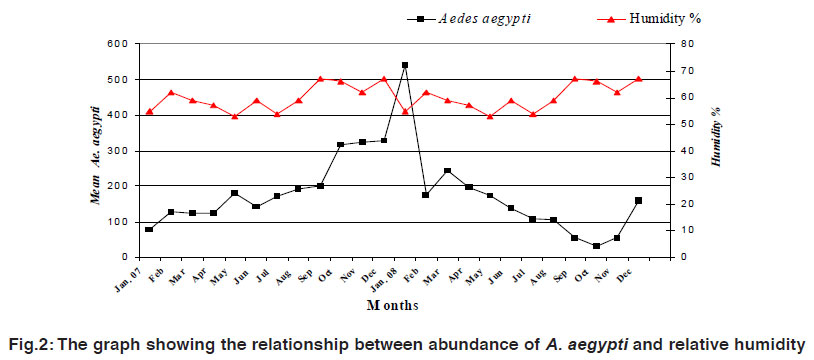Role of climatic factors in the seasonal abundance of Aedes aegypti L. and dengue fever cases in Jeddah province of Saudi Arabia
Khalid Al-Ghamdi1 * , Masroor Ali khan1 and Jazem Mahyoub1
1
Laboratory for Mosquito Research,
Municipality,
Jeddah
Kingdom of Saudi Arabia
DOI: http://dx.doi.org/10.12944/CWE.4.2.07
Fluctuation in the climatic factors influences not only the human health but also affect the abundance of disease vectors as well as infectious diseases. In the present study an attempt has been made to establish the relationship between Aedes mosquito abundance, dengue fever cases and prevailing climatic factors in the western region of Saudi Arabia. The role of Relative humidity is well established in the abundance of mosquito vector. But the role of temperature & rainfall is unpredictable in this area of study.
Copy the following to cite this article:
Al-Ghamdi K, Khan M.A, Mahyoub J. Role of climatic factors in the seasonal abundance of Aedes aegypti L. and dengue fever cases in Jeddah province of Saudi Arabia. Curr World Environ 2009;4(2):307-312 DOI:http://dx.doi.org/10.12944/CWE.4.2.07
Copy the following to cite this URL:
Al-Ghamdi K, Khan M.A, Mahyoub J. Role of climatic factors in the seasonal abundance of Aedes aegypti L. and dengue fever cases in Jeddah province of Saudi Arabia. Curr World Environ 2009;4(2):307-312. Available from: http://www.cwejournal.org?p=195/
Download article (pdf)
Citation Manager
Publish History
Select type of program for download
| Endnote EndNote format (Mac & Win) | |
| Reference Manager Ris format (Win only) | |
| Procite Ris format (Win only) | |
| Medlars Format | |
| RefWorks Format RefWorks format (Mac & Win) | |
| BibTex Format BibTex format (Mac & Win) |
Article Publishing History
| Received: | 2009-11-18 |
|---|---|
| Accepted: | 2009-12-20 |
Introduction
Climate change has a direct influence on human health. Apart from affecting the human health climate change also influences the vector of infectious diseases.
Climate change and its influence on the vectors of infectious diseases has been a subject of serious debate and study (Shope, 1991). Most of the mosquitoes are sensitive to climate and primary vectors for many diseases. The primary vector for dengue fever virus transmission to humans is Aedes species. The global warming influencing the climate and resulting into speeding up the development of virus in mosquito vectors and increasing their capacity to adapt to different climatic factors and habitats (Abdalmagid MA & Alhusein, (2008). Dengue mosquito populations usually influenced by environmental factors, these factors are important for controlling the density of Aedes (de Cesas et al., 1995)
Christopher,(1960); Focks et al., (1993b) and Rueda et al., (1990), are of the opinion that geographical distribution and development of the mosquitoes is largely determined by climate of the region. Patz, JA (1998) suggested that if the climate change continue to occur, this will increase the epidemic potential of dengue fever and dengue carrying mosquitoes.
A number of studies suggested that climate change affects the density of mosquitoes (Zwerver, S. et al., 1995; Rueda, L.M. et al., 1991; Hopp, M.J. and Foly, J.A., 2001; Shope,1991).
WHO estimated that climate change may be the cause of increase in the number of dengue fever cases and related deaths. Over the past few years there has been a drastic increase in dengue fever cases all over the world (WHO, 1996). Many workers studied the relationship between dengue fever cases and climatic factors. Chadee et al., (2007) found relationship between rainfall and dengue fever cases, Promprou et al., (2005) with temperature, rainfall and moisture. Dibo M.R. et al., (2008) recognized the climate as an important factor to asses the density of Aedes and dengue fever cases.
Recently Beebe NW et al., (2009) challenged the common view that climate change will increase and spread the Aedes aegypti. They further suggested that the human behavior is increasing the risk of dengue.
In Jeddah the situation is alarming as number of dengue fever cases is increasing rapidly. First time dengue virus was isolated in 1994 in Jeddah (Fakeeh & Zaki, 2001) and by the end of year 300 cases were diagnosed. The year 2006 was the worst year for Jeddah as 1300 cases of dengue fever were recorded. Due to extensive efforts of Jeddah Municipality the number came down to 342 in 2007. But the prevailing conditions in the city such as high humidity, lack of proper sewage disposal network, rapid growth of unplanned slums and large number of pilgrims visiting the holy cities of Makkah & Medina via Jeddah provided the ideal conditionsfor increasing the population of Aedes mosquitoes (Aburas,HM 2007) and rise in dengue fever cases.
The focus of this study is to find out an association between climatic factors and Aedes mosquito abundance in the study area. And to find out the relationship between mosquito abundance & dengue fever cases.
Methodology
Mosquito abundance was recorded with the help of adult mosquito surveillance. A through sampling was carried out by installing the Black Hole Light Traps (Gangnam-Gu,Seoul, 135-744,KOREA) in various habitats of the city.12different vulnerable points were selected in city to install the traps (Fig.1).
 |
Figure 1: Locations of Black Hole Light Traps installed in Jeddah city Click here to view figure |
Powered aspirators were also used to collect the adult mosquitoes from their resting places. Trapped & collected mosquitoes were than brought to the laboratory for identification of Aedes mosquitoes especially Aedes aegypti.
Meteorological data on various weather parameters were collected from the records of National meteorology & Environment center, Jeddah.
Complete two years work provided well connected and useful information pertaining to Aedes aegypti density and dengue cases in Jeddah. The data is analyzed on year to year basis. Climate variables include temperature, relative humidity & rainfall from January 2007 to December 2008. Temperature is measured in degree Celsius and recorded as mean temperature. Relative humidity is the average humidity and expressed in percentage. Rainfall recorded in millimeters.
Data were analyzed using SAS statistics software (version 6). Data were analyzed in order to find relationship & correlation between climatic factors, Aedes mosquito population and dengue fever cases in the study area.
Results
In the following analysis of results, correlations were used to explain the relationship between different climatic factors & abundance of Aedes population in time & space using data collected during two consecutive years 2007 & 2008.
The Aedes mosquito abundance and its association with the climatic factors are determined and it was observed that maximum number of Aedes was collected during the month of January 2008 (Fig.2). The average temperature was recorded 23°C (Max. 35°C & Min. 28°C). Average Relative humidity during this period was 55% (Max. 90% & Min. 19%) and the total rain fall during this month was recorded only 2.7 mm.
Pearson's Correlation coefficient values suggest highly significant relationship between Aedes population and relative humidity (Table 1 & 2). It was observed that the temperature and rainfall do not exhibit any significant relationship with the population abundance of Aedes aegypti mosquito.
 |
Table 1: Pearson's correlation values between climatic factors and Aedes density Click here to view table |
 |
Table 2: Correlation between climatic factors and dengue fever cases Click here to view table |
 |
Figure 2: The graph showing the relationship between abundance of A. aegypti and relative humidity Click here to view figure |
Number of dengue fever cases was recorded high especially during June 2008 when the average relative humidity was 59% and meantemperature was approximately 32°C. During this period a small amount of ra nfall (2.7mm.) was also recorded (Fig. 3). The correlation between dengue fever cases and climatic variables do not show any significant value except with relative humidity during year 2007. The results for the year 2008 show high significant relationship between dengue fever cases and all the three climatic variables (Relative humidity, Temperature & Rainfall (Table 1 & 2).
Discussion
As all the weather parameters are very much interrelated therefore, it is difficult to explain the influence of individual factors. On the basis of recorded observations an attempt has been made here to correlate the density of Aedes aegypti mosquito and dengue fever cases in Jeddah with the average range of prevailing weather factors such as Relative humidity, Temperature and Rainfall.
Results of our present study reveal that in the area of study the relative humidity is found playing crucial role in the population abundance of Aedes aegypti as it helps in longevity & development. This view is in full agreement with earlier workers including Hales et al., (2002), Promproue et al., (2005) & Favier et al., (2006). Although Kreor, (1980) was of the opinion that high humidity is not so important to Aedes mosquito abundance.
Rainfall significantly influences the abundance of mosquitoes (WHO,1996). As there is very little rainfall in this area even than the number of Aedes aegypti is high especially during winter months. This abundance may be attributed to the prevailing conditions in the study area where there is no proper sewage network, covered drains etc. people store water in water receptacles in or out side homes and provide ideal breeding places for Aedes aegypti and help in their abundance and spread of dengue fever cases. Reiter (2001) stated that in the areas where the mosquito breeds in the stored water their population is high and dengue transmission is also high. Buttiker, (1981) also expressed same views for mosquito population in Saudi Arabia.
The temperatures usally high during the day but nights are cooler. Buttiker, (1981) opined that temperature prevailing in Saudi Arabia (Some time as high as 48°-49°C) may be lethal for the mosquitoes and during spring & autumn peak in mosquito population occur.Reiter (2001) opined that the effect of temperature on mosquito survival and abundance is difficult to predict. We also support his views as far as the study area is concern.
The spread of Aedes aegypti in this region is related more too human behavior than to climate. Domestic water storage and stagnant water in open air containers with inflow of pilgrims from dengue affected countries are some of the reasons for dengue fever cases in this region. As suggested by Mariappan (2009) awareness in water storage practices and removal of stagnant water could drastically reduce the density of Aedes aegypti in Jeddah Province of Saudi Arabia.
Acknowledgements
We are thankful to all our colleagues in the Municipality, Jeddah, who have been the fountain of our inspiration in conducting this research. We would also like to thank National Meteorology and Environment Center for providing the meteorological data for Jeddah city.
References
1. Abadalmagid MA & Alhusein Sh.H. Entomological investigation of Aedes aegypti in Kassala and Elgadarief State, Sudan; Sudanes J. Pub.Health (2008) 3(2): 77-80.
2. Aburas HM: Aburas Index: A statistically developed Index for dengue Transmitting Vector population prediction. PWASET (2007) 23: 151-154.
3. Beebe NW, Cooper RD, Mottram P, Sweeney AW. Australia's Dengue Risk Driven by human adaptations to climate change. PLoS Negl. Trop. Dis. 3(5): e429 (2009). 3. Buttiker W: Observation on urban mosquitoes in Saudi Arabia. Fauna of Saudi Arabia (1981) 3: 472-479.
4. Christophers SR: Aedes aegypti (L). the Yellow Fever Mosquito. Its life history, Bionomics and structure. Cambridge: Cambridge University Press (1960).
5. De Casa C, Conicetu SI, Verhassett Y, Carcavallo RU & Boffi R. Environmentalrisk factors for disease transmittedby vectors: a case study in North- Argentina. Geo Journal. (1998) 44(2): 121-127 Netherlands. Kluwer Academic Publisher.
6. Dibo M.R et al., Study of the relationship between Aedes (stegomyia) aegypti egg and adult densities, dengue fever & climate in Mirassol, State of Sao Paulo, Brazil. Mem Inst. Oswaldo Cruz, Rio de Janeiro. (2008) 103(6): 554-560.
7. Fakeeh & Zaki. Virologic & serologic surveillance for dengue in Jeddah, Saudi Arabia. The American J Trop. Medi. & Hyg. (2001) 65: 764-767.
8. Fakeeh & Zaki. Dengue in Jeddah, Saudi Arabia 1994-2002, Dengue Bulletin. (2003) 27: 13- 18.
9. Focks DA, Haide DG, Daniels, E Mount GA. Dynamic life table model of Aedes aegypti (Diptera: Culucidae): analysis of the literature and model development. J. med. Entomol. (1993) 30: 1003-1017.
10. Favier C, Degallier N; Vilarinhos PTR; Carralho MSL; Yoshizawa MAC; Knox MB. Effects of climate and different management strategies on Aedes aegypti breeding sites: a longitudinal survey in Brasilia ( DF; Brazil) Trop. Med. Inter. Health (2006) 11: 1104-1118.
11. Ghaznawi H, Al khateeb To, abrar N, Afifi H & Nasser A. Surveillance for dengue fever in Jeddah Eastern Mediterranean. Health Journal. (1997) 3: 567-570.
12. Hopp MJ & Foley JA. World wised fluctuations in dengue fever cases related to climate variability. Climate Research. (2003) 25: 85-94.
13. Kreier JP. Malaria volume 2. Pathology, vector studies and culture. Acad Press, New York (1980).
14. Mariappan T. Dengue transmission. Environ. Health Perspective. (2009) 117(2).
15. Patz JA; Martens WJM; Focks DA; Jetten TH. Dengue fever epidemic potential as projected by general circulation models of global climate change. Environ. Health Perspect. (1998) 106: 147-153.
16. Promprou S; Jaroensutasinee M; Jaroensutasinee K. Climatic factors affecting dengue haemorrhagic fever incidence in Southern Thailand. Dengue Bulletin (2005) 29: 41- 48.
17. Reiter P. Climate change and mosquito-born diseases. Envron. Health Perspect.; (2001) 109(suppl.1): 141-152.
18. Rueda LM et al., Temperature dependent development and survival rate Of culex quinnqyefasciatus and Aedes aegypti (Diptera: Culicidae). J. Med Entom. (1990) 27: 892- 898.
19. Reiter P. Climate change and mosquito-borne disease. Environ. Health perspect. (2001) 109(Suppl.1): 141-152.
20. Shope, R:Global climate change and infectious disease. Env. Health Perspect.(1991) 96: 171-174.
21. WHO: Climate change & human health, WHO, Geneva (1996).
22. Zwervers S et al., Climate change Research Evaluation and policy Implication Volume 2, Elsevier Science publishing Co. Inc. Amsterdem (1995).






